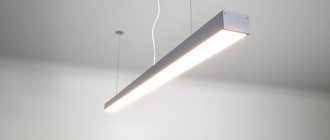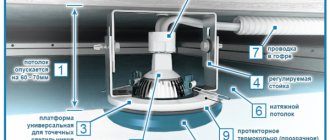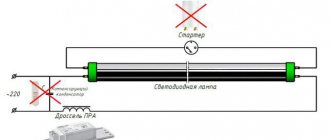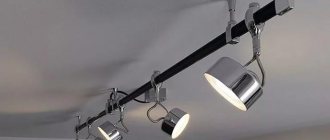An LED emergency lamp with a battery is indispensable in case of problems with the electrical network voltage. An emergency power source will provide autonomous lighting, which allows people to continue or finish work in the absence of voltage, and if necessary, safely leave the premises. And in case of an emergency (fires, explosions, accidents) it will allow you to evacuate in time. The battery life of the LED lamp lasts several hours. According to safety standards, such lamps are required to be in public and industrial premises.
Power outages in a hospital, a tunnel, or a factory lead not only to economic damage, but also pose a danger to human life. Therefore, such facilities must be equipped with an emergency power source.
Types of emergency LED lamps
- Evacuation. Such lighting is installed in places where signs are located (exit, exit) and along the path of the evacuation plan (flights of stairs, exits, corridor intersections). The special emergency lighting lamp “Exit” is designed to indicate an emergency exit from the facility.
- Reserve . The lights turn on automatically so that the process is not interrupted. This is especially true for production, hospitals, transport control panels, power grids and other points where the lack of light poses a danger to life.
- High danger zones. Lighting is provided by explosion-proof lamps, used in conditions in which loss of light can lead to death or injury to people: oil and gas production enterprises, the nuclear industry and gas stations. Explosion-proof lamp with emergency power supply, resistant to dust and moisture. The device case is sealed and shockproof. The anodized coating (oxide film) reliably protects against chemicals and corrosion. Operating temperature from -50 to +50C.
Emergency lighting locations
Emergency exit lighting is part of an emergency lighting system that ensures the safety of people leaving a danger area. This is a mandatory requirement of fire safety standards. Leaving the building with access to the street is the main task of an emergency exit. It is also the main route for rescue services to operate.
Evacuation route lighting - identifies the escape route and ensures that it is sufficiently illuminated. This includes illuminated fire exit signs as well as emergency lighting. The escape route requires at least 1 lux on the floor in the center of the escape route and 0.5 lux in the adjacent area.
Backup lighting is a part of the emergency lighting system that allows normal operations to continue without significant changes. This is the only type of emergency lighting whose main task is not related to the evacuation of people. As a rule, these are places that support human life (hospitals, clinics, government agencies), as well as enterprises with a continuous cycle of work.
How to choose an emergency lamp
To determine the choice of a suitable model, you should consider the following characteristics:
- Emergency battery power. All lamps, including evacuation models marked “Exit,” must have the required power to provide lighting in a certain area. To accomplish this task, the battery must have sufficient capacity. Otherwise, the lamp will not be functional enough and will not work for long. The power of the emergency lighting lamp varies from 1.4 to 18 watts. The average battery capacity is 1300 mAh–3000 mAh. The power of LED lamps is lower than other types of lighting sources, but the light itself is much brighter.
- Battery life. The longer the device is used, the lower the charge capacity. Battery life is 4–12 years (32040–100000 hours) with continuous operation (about 300 charge/discharge cycles).
- Battery life. Minimum duration 1.5–2 hours. The time depends on the battery capacity. Some lamps work up to 7 hours.
Types of emergency lamps
The purpose of LED power supplies differs not only in types, but also in types.
Light source
There are LED lamps and flashlights. Emergency lighting, in addition to its main purpose, can be used when performing various work in a garage or warehouse. The emergency lamp with battery is an LED flashlight that is useful in nature, on a hike, or during emergency stops on a trip. It will help the user out in the dark. This lamp is easy to carry, as it weighs little, is equipped with a retractable handle, and has compact dimensions. The operating time of the models varies from 6 to 20 hours.
Protection class
For each specific room there are certain criteria. Constant lamps have a degree of protection IP42, IP65. Lamps operating in intermittent mode are characterized by class IP22, IP42, IP65. Combined lighting has a degree of IP22, IP42, IP65.
Mounting type
- Hanging. They are equipped with hooks, ceilings, and pipes for special suspended installation. Installed in rooms with high ceilings.
- Wall-mounted. Designed for mounting on walls or other vertical surfaces. Mounted at an angle on swivel brackets. The power of the external emergency power source varies from 50 to 800 Watts. The devices are mounted on supports at a height of up to 50 meters.
- Portable. The flashlight moves to the required location. In cases where the IAP is far from the destination.
Operating mode
Luminaires with an emergency power supply are of the following types:
- Permanent. The lamp is connected to the mains at all times. The battery is continuously charged and ready for use in emergency conditions. When there is a power outage, it switches to offline mode and continues to operate using the built-in battery. The device can be used as a permanent work light. Lamps are used not only in public or industrial places, but also in apartments or in the country. This provides light during a temporary outage.
- Fickle. The device starts working only when there is no central power supply. Lighting is provided by a built-in battery, which is charged when voltage is present.
- Combined. A special switch regulates the mode of constant and intermittent operation. The design of such a lamp is represented not by one lamp, but by several. Some work constantly from the standard network, others are recharged at this time, and in the absence of power they begin to function from the battery.
When should emergency lighting be provided?
The emergency lighting system performs its main task - it ensures the safe evacuation of production personnel in situations where there is a threat to their life and health. In addition, the design of this system is necessary for enterprises where processes take place, the interruption of which is fraught with disasters. In this regard, the design of this system always involves the placement of lighting fixtures along the safe exit route.
Note! Such wiring and placement of lighting installations is prescribed in the PUE.
As a result, such design allows the directions of movement to be illuminated as fully as possible. In this case, the minimum light falls on the center of the corridor.
Emergency lighting in the corridor
In this regard, a combined system of working and emergency lighting should always be installed in places with an increased risk of injury. An example of such areas:
- flights of stairs;
- locations of complex and dangerous equipment;
- equipment that is part of the life support system;
- places where a device is located that must always be under control (for example, reactors, etc.);
- exits from premises and buildings;
- bends of corridors, etc.
The presence of emergency lighting in such premises allows not only to reduce injuries to personnel during evacuation, but also to minimize panic, which is very important in such situations.
Advantages of LED emergency lights
- Long operating time of 30 thousand hours.
- Economical energy consumption. Consumes 10 times less energy compared to a conventional incandescent lamp.
- Easy to use. Periodic checking of the battery charge is required.
- Maximum brightness immediately after switching on. The light is flicker-free and does not dazzle.
- Impact resistance. The diodes do not have a filament, so they are vibration-resistant. The glass is made of polycarbonate, which can withstand a shot from an air gun.
- A wide variety of bases allows you to replace the lamp due to burnout or insufficient power.
- Environmentally friendly. The devices are absolutely safe for human health.
- Installation of these emergency power supplies is simple. Anyone can do it.
- The device does not heat up more than 60 degrees, as it uses low power.
The disadvantage of an LED emergency lamp is the need to monitor the constant charge of the battery.
Emergency lamp design
Emergency lighting luminaires are equipped with rechargeable lithium or acid batteries and LED power drivers.
The battery is charged by connecting to the network; the LEDs do not light up. The first battery charge requires up to 48 hours. According to safety regulations, the charge should be enough for an hour.
Emergency lighting with a battery ensures autonomous operation of the power source throughout the operation of the device. A new lamp must be completely discharged once. It is also recommended to do this once a year as a functionality check.
A preventive check is carried out as follows: the emergency lamp is disconnected from the network, the emergency mode should turn on. The lamp operates until the battery is completely discharged.
Installation
Emergency backup power supplies with auto-start must be installed in production and administrative premises. All installation work must be carried out in compliance with the requirements of regulatory documents (SP 256.1325800.2016 “Electrical installations of residential and public buildings. Design and installation rules”; SP 52.13130.2011 “Natural and artificial lighting. Updated edition of SNiP 23-05-95*”; GOST -R-55-842.2013 “Emergency lighting”, rules for the design of electrical installations and rules for the technical operation of consumer electrical installations).
The installation of an additional alternating current network, with the same power and voltage indicators, is carried out in parallel with the main one. Reconnection occurs in one minute, allowing for normal production processes.
Evacuation
The list of consumers is divided into three types:
1. The first category is strategic objects where turning off electricity can lead to catastrophic consequences (injury and death of people, violation of the strategic security of the state, etc.). In such premises, an additional electrical network must be installed, the power of which is the same as that of the main network. If the backup electrical network fails, lithium-ion batteries connected in parallel to electric generators (diesel or gasoline) must be used. It is permitted to use other emergency sources that can maintain the operation of the network during the period of time while restoration work is being carried out to restart the main power grid.
You may be interested in Features of illumination calculation
2. The second category is production and other buildings in which the lack of electricity can lead to significant downtime, defective products, and disruption of equipment. At these facilities, the same measures are taken to operate emergency power, but outages of insignificant duration are allowed. The main difference is the manual activation of the security lighting by the personnel on duty. Most administrative and production premises belong to the second category.
3. The third category is facilities where a lack of electricity is allowed during the day. These premises do not have a high-power emergency light source. Here, emergency and safety lighting is started automatically or manually using generators or batteries. Evacuation lighting devices are activated automatically when a fire alarm sounds.
In rooms with a small area, it is possible to install lamps that have their own battery, which allows them to shine in the absence of electricity and subsequently receive a charge after the power supply is turned on.
Why LED Emergency Battery Light is Better
A battery-powered IAP is significantly better for several reasons.
The lamps operate independently of the main power supply system. When the central line is turned off, they continue to function.
Important! For full operation, the battery must be fully charged. This can be achieved by a permanent connection to the electrical network or the state of charge must be constantly monitored. Some models are equipped with a charge indicator.
Placement scheme and standards
Proper planning of emergency lighting is critical.
A lighting device with the inscription “Exit” is equipped along the route and above the door itself. Items where emergency lighting is required include office premises, elevators, places of special danger, stairs, large rooms, escalators, corridors, tunnels. Each doorway is equipped with a sign marked “Exit”.
Emergency lighting is a mandatory measure when designing public and industrial facilities.
Emergency lamps must provide high-quality illumination of the evacuation route. When choosing a device, you should take into account the width of the room.
LED emergency lights with battery for emergency lighting are indispensable to ensure people's safety. Having many advantages over other types of lamps, the LED power source significantly prevails in all technical characteristics. Equipping with a battery guarantees full illumination where it is needed.
Design standards
The light levels on the surface when starting security lighting should be at least 10 lux for incandescent lamps, and for fluorescent lamps this figure should be at least 15 lux.
Evacuation light indicators in narrow corridors and small rooms must be at least 0.5 lux. In large and bright rooms this figure can be from 0.2 lux.
Design
In large rooms, escape routes must be equipped with indicating arrows located in the direction of the emergency exit. Signs must be placed at least every 25 meters and at every turn. The installation location may be the walls or even the ceiling of the room, but within the visibility of the evacuated personnel. Instead of arrows, it is allowed to install decorative lighting fixtures with an arrow stencil made in accordance with the standards. These rules and regulations apply to the following objects:
- The area of the production workshop exceeds 150 m2;
- there is a room with 100 people or more at the same time;
- objects where there is no natural light source and there are 50-100 personnel at the same time.
You may be interested in this Features of the E27 base
Emergency lighting must be connected to a backup network and not depend on the main electrical network. Evacuation lighting and safety lighting should be independent, but at the same time they should complement each other. For this purpose they are connected to their own power supply.
Emergency devices can function continuously, complementing the central lighting, and can also be connected (in manual or automatic modes) in the event of an emergency.
When devices automatically switch to backup power, it is necessary to consider the possibility of returning to the main power source when the central network is restored.
If it is impossible to use an automatic transfer, it is necessary to install a special panel equipped with mechanical switches, allowing the personnel on duty to manually turn off the backup power and connect to the main electrical network, in accordance with the operating instructions and observing safety requirements.
Lamps equipped with batteries have separate requirements. Due to their low power, they are used for installation in evacuation lamps and are turned on in rare cases. To ensure that the battery does not self-discharge and does not provide power to the lamp at the right time, these devices are equipped with a remote control. With its help, the equipment is checked for serviceability and, if necessary, the battery can be charged in the future.
Important! It is prohibited to connect more than 20 light sources to one emergency power supply network. The total power of this equipment should not be more than 60% of the ability to protect the emergency power grid.
Luminaires must be installed in such a way as to provide uniform light for escape routes. To avoid disorientation of personnel during evacuation, it is necessary to avoid sudden changes when installing lighting fixtures.
Lamp
Lamps indicating directions during evacuation must have designs with clear boundaries that are understandable to people.
Additional Information! The colors applied to the lamp should not develop panic feelings and should not have an aggressive palette. The most suitable color is green.
Light sign
Equipment designed to start and turn off emergency lighting must be mounted in a special place that is accessible to maintenance personnel and at the same time inaccessible to unauthorized entry by other persons not involved in the process. Devices must be protected by fireproof cabinets with mandatory marking of all elements.
It is prohibited to install an emergency power supply network in parallel with the main network. In this case, if a malfunction occurs in the main network, there is a high possibility of problems occurring on the backup network. The latter must have an individual gasket and have independent equipment. In addition, all installations must be equipped with fire partitions.
When installing the emergency lighting system and its components, it is necessary to avoid areas where there is a high risk of any emergency. Launch equipment must be placed in premises that are the safest and have easy access in the event of an emergency.
Emergency light
It is necessary to periodically check the equipment by starting and switching it. Special equipment in the form of test programs is used for inspections (mandatory for the first category). Drill evacuation is carried out at facilities belonging to the second and third categories (it is necessary to obtain approval from the relevant security authorities).
Requirements











